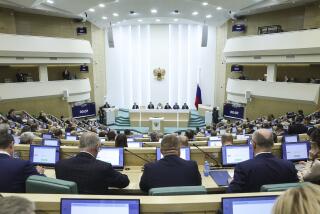Mother Russia Comes to America’s Heartland as Soldiers Practice Peace : Military: First joint exercise on U.S. soil could be run-up to deployment in Balkans. But tangle over who would command troops relegates Kansas operation to trial only.
- Share via
FT. RILEY, Kan. — Army Maj. Gen. Randolph W. House gazed out over the parade ground. In a hearty voice that rolled across the prairie, he declared: “Oh, what a great day to be a soldier!”
Under a gray sky, on a field rich in the autumn gold of the Flint Hills of Kansas, 150 Russian soldats joined hands Thursday with U.S. soldiers at a turning point in each nation’s history.
After the fall of Soviet communism, Mother Russia was now a guest in the American heartland. In the first joint U.S.-Russia military operation on American soil, troops from the two countries began training for global peacekeeping.
It was something never dreamed of during the dark winters of the Cold War. But the old Soviet bear is gone, and with it most of the distrust.
Most, but not all. For although Russian political leaders want to help with any peacekeeping mission in war-ravaged Bosnia-Herzegovina, they refuse to do so if it means submitting their troops to the command of the North Atlantic Treaty Organization, which for decades existed to counter Soviet agression.
Until that issue is settled, the former American and Russian foes are relegated to joining hands on the practice fields of Ft. Riley, where on Thursday the small contingent of Russian fighters seemed dwarfed alongside the U.S. Army’s 1st Infantry Division.
That famed American division, known as the Big Red One, helped fight two world wars in Europe this century, including participating in the 1944 D-day landings, and remained in Germany after World War II as one of the original contingents in NATO.
Likewise, Russia’s 27th Guards division is steeped in history. It won the prestigious Order of the Red Banner in 1944 for its effort along the Stalingrad Front in blocking Hitler’s German troops.
At Ft. Riley, the old foes shared rifles. They traded cigarettes. They snapped pictures and signed autographs. Army Spec. Jim Probst, 25, of East St. Louis, Ill., showed his Russian counterpart, Pfc. 1st Class Nikolai Ledashev, 18, how to strap an American gas mask to his head.
The Russians will eat and sleep the soldier’s life with American GIs here. Over the next 10 days, they will learn how to handle new U.S. weapons technology, share ideas on such basic matters as guard duty and checkpoints, and talk strategy about how both sides might someday come together in a real joint peacekeeping endeavor.
“If we are called upon to do that, we can and will make it work,” pledged Lt. Col. Vitaly N. Mereyanin, 33, a 16-year veteran of the former Soviet and now the Russian army.
U.S. Army Spec. Steven Miller, 28, of Sacramento, took an even longer view. “It all depends on what happens with this Bosnia situation,” Miller said. “If we get into it with them over NATO, it might dampen all of our peaceful relations with the Russians.”
*
Called “Peacekeeper-95,” the current training follows a similar effort a year ago when U.S. Army members stationed in Germany underwent peacekeeping training in Totskoye, Russia.
Today, U.S. Defense Secretary William J. Perry and Russian Defense Minister Pavel S. Grachev will visit here and inspect the joint exercises.
On Saturday, the leaders plan to go to Whiteman Air Force Base in Missouri. There, Grachev will help blow up one of the underground silos that once housed a nuclear missile aimed at the Soviet Union.
“This visit is primarily important for symbolic reasons,” Dale R. Herspring, head of the political science department at nearby Kansas State University, wrote recently in an article published by the Manhattan (Kan.) Mercury newspaper and widely circulated around the army base.
“The fact that it is occurring at all says a lot about the desire of both countries to overcome numerous obstacles.”
The 150 members of the Russian 27th Guards Motorized Rifle Division flew to Wichita on Wednesday and were bused two hours north to Ft. Riley. They passed wide farmland soon to be covered in winter wheat, much like the countryside around their own homes along the Volga River.
The joint training kicked off Thursday morning after a full-honors ceremony on the parade ground. The red, white and blue of both flags were presented. A Ft. Riley band played both national anthems, along with army tunes from both countries.
House, in welcoming his guests, recalled the adage that “nobody desires peace more than a soldier.” He spoke eloquently about the history of the moment, his words echoing from two loudspeakers except when he stopped to allow a Russian translator to catch up.
He promised his guests that they would find “warmth, hospitality and genuine friendship” in the United States. He talked about military dedication and sacrifice and “duty first.” He praised “the soldier on the field today.”
He was followed by Col. Gennady M. Averyanov, commander of the Russian troops. “May our two great nations now do more for the cause of peace,” Averyanov said.
*
But not all minds were on training exercises.
Averyanov wants to learn to play golf. Pfc. Yuri Charushin, an 18-year-old whose father and grandfather served in the Soviet army, asked about an exhibit called the “Treasures of the Czars” down the interstate in Topeka.
And Ledashev expressed interest in tickets to a Madonna concert.
More to Read
Get the L.A. Times Politics newsletter
Deeply reported insights into legislation, politics and policy from Sacramento, Washington and beyond. In your inbox twice per week.
You may occasionally receive promotional content from the Los Angeles Times.











